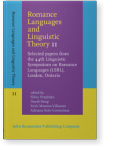Chapter 3
How French sheds new light on scalar particles
This paper examines the behavior of the French scalar focus-sensitive particles même, quand même, ne serait-ce que, and seulement as compared to English even and only. I first show that French même displays a more restricted distribution than even; this behavior and that of its antonym quand même argue for the scope theory against the ambiguity theory of even. Secondly, I demonstrate that the behavior of ne serait-ce que and seulement reveal the existence of an intrinsic link between even-like particles and only-like particles. To capture this observation, and more generally the organic relation between scalar particles, I propose a new, parsimonious, theory that builds scalarity, additivity, and exclusivity of scalar particles into a conjunctive or disjunctive meaning.
Article outline
- 1.Introduction
- 2.How même and quand même argue in favor of the scope theory
- 2.1Background: The two theories of even and their issues
- 2.2
French même
- 2.3
French quand même
- 3.How French scalar particles reveal an intrinsic link between even and only
- 3.1
Ne serait-ce que
- 3.2
Seulement
- 3.3Crosslinguistic link between even and only
- 4.A new theory of scalar particles
- 4.1
French seulement
- 4.2
French même, quand même, ne serait-ce que
- 4.3Crosslinguistic consequences
- 5.Conclusion
-
Notes
-
References
References (22)
References
Beaver, David I., and Brady Z. Clark. 2008. Sense and Sensitivity: How Focus Determines Meaning. Blackwell Pub. 

Crnič, Luka. 2011.
Getting even. MIT Dissertation.
Gast, Volker, and Johan van der Auwera. 2011. “Scalar Additive Operators in the Languages of Europe.” Language 87 (1): 2–54. 

Giannakidou, Anastasia. 2007. “The Landscape of EVEN.” Natural Language and Linguistic Theory 25 (1): 39–81. 

Guerzoni, Elena. 2003. Why Even Ask? On the Pragmatics of Questions and the Semantics of Answers. MIT Dissertation.
Herburger, Elena. 2000. What Counts: Focus and Quantification, vol. 36. The MIT Press.
Horn, Laurence R.. 1971. “Negative Transportation: Unsafe at any Speed”. CLS 7: 120–133.
Karttunen, Lauri, and Stanley Peters. 1979. “Conventional Implicature.” In Syntax and Semantics, ed. by C.-K. Oh, and D. A. Dinneen, vol. 11, 1–56. Academic Press.
Klinedinst, Nathan. 2004. “Only Scalar Only
.” Handout at Presupposition and Implicature Workshop, Paris.
König, Ekkehard. 1991. The Meaning of Focus Particles. London: Routledge. 

Lahiri, Utpal. 1998. “Focus and Negative Polarity in Hindi.” Natural Language Semantics 6: 57–123. 

Lerner, Jean-Yves, and Thomas E. Zimmermann. 1981. “Mehrdimensionale Semantik. Die Präsuppositionen und die Kontextabhängigkeit von nur
[Multidimensional Semantics. The Presuppositions and Context Dependency of nur
].” Arbeitspapier des Sonderforschungsbereichs 99. Universität Konstanz
Nakanishi, Kimiko. 2006. “
Even, Only, and Negative Polarity in Japanese.” Proceedings of SALT 16: 138–155. 

Rooth, Mats. 1985. Association with Focus. University of Massachusetts, Amherst Dissertation.
Rooth, Mats. 1992. “A Theory of Focus Interpretation.” Natural Language Semantics 1 (1): 75–116. 

Rullmann, Hotze. 1997. “
Even, Polarity, and Scope.” Papers in Experimental and Theoretical Linguistics 4: 40–64.
Schwarz, Bernhard. 2005. “Scalar Additive Particles in Negative Contexts.” Natural Language Semantics 13: 125–168. 

Shank, Scott. 2002. “
Just and its Negative Polarity Variants in Salish.” Ms. University of British Columbia, Vancouver.
Tomaszewicz, Barbara M. 2012. “A Scalar Opposite of Scalar Only
.” Proceedings of the 30th West Coast Conference on Formal Linguistics: 324–334.
Wilkinson, Karina. 1996. “The Scope of Even
.” Natural Language Semantics 4: 193–215. 

Zwarts, Franz. 1998. “Three Types of Polarity.” In Plurality and Quantification, ed. by F. Hamm, and E. Hinrichs, vol. 69, 177–238. Kluwer. 

Cited by (1)
Cited by one other publication
Greenberg, Yael
2022.
On the scalar antonymy of only and even.
Natural Language Semantics 30:4
► pp. 415 ff.

This list is based on CrossRef data as of 16 july 2024. Please note that it may not be complete. Sources presented here have been supplied by the respective publishers.
Any errors therein should be reported to them.
